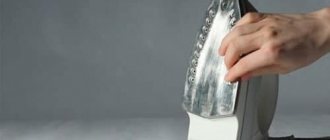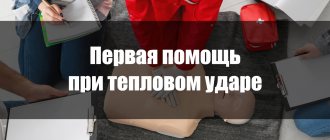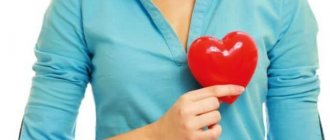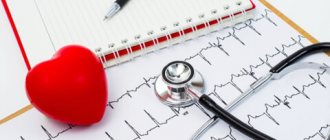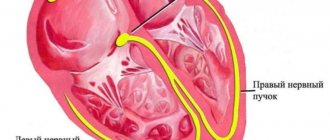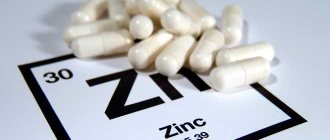An ordinary person who is not familiar with the concept of arrhythmia, its symptoms, features of first-aid care and treatment is often taken by surprise by a sharp disturbance in the frequency of contractions of the heart muscle, the occurrence of discomfort or pain localized in the chest area. Of course, in such cases it is necessary to immediately consult a doctor for emergency medical support. However, a popular saying used by the inhabitants of Ancient Rome says: those who are forewarned are no longer unarmed. Therefore, information on how to relieve an attack of arrhythmia at home will definitely not be superfluous.
Cardiac arrhythmia: what is it?
Normally, the number of beats per minute of a healthy person’s heart ranges from 60 to 90 beats. Athletes and older people usually have a slow pulse, while children and teenagers have a more frequent pulse. Bradycardia is diagnosed in cases where pulsation indicators are below 60 beats per minute. Tachycardia is defined as a heartbeat of 100 beats or higher. The paroxysmal type is characterized by a sudden onset of an attack and a high heart rate of more than 145 beats per minute. To establish the exact form of the pathology, it is necessary to do an ECG and undergo a number of additional tests.
Tachycardia is most often provoked by:
- ischemic disease;
- hereditary factors;
- dystrophy and other myocardial abnormalities;
- heart defects;
- cardiomyopathy;
- atherosclerosis;
- heart attack.
Disturbances in the frequency of contractions of the heart muscle often occur due to previous surgical operations, uncontrolled use of pharmaceuticals, pathological abnormalities in the functioning of the endocrine and nervous systems, hormonal imbalance, obesity and various diseases of the internal organs. At increased risk are people who are regularly exposed to physical or mental stress, as well as those who abuse alcohol and drinks with a high caffeine content.
Why does it occur
The main reasons for the development of heart rhythm disturbances:
- ischemia;
- myocardial infarction;
- heart failure;
- congenital or acquired pathologies;
- vegetative-vascular dystonia;
- bronchitis, pneumonia;
- bronchial asthma;
- diabetes;
- excessive consumption of alcohol, drugs, smoking;
- anemia;
- thyroid diseases;
- uncontrolled use of certain medications - diuretics, antiarrhythmics.
Only a doctor can determine the etiology of such manifestations after a full examination.
Types of arrhythmias, their symptoms and signs
The most common disorders of the automatic functioning of the sinus node are:
- Sinus-type arrhythmia, which is an abnormal heart rate and is diagnosed mainly in young patients.
- Bradycardia. Characterized by a slowing of the myocardial rhythm.
- Tachycardia (sinus), which is characterized by a rapid heartbeat of 100 beats per minute and above. A failure occurs most often due to emotional arousal or increased physical activity. It can be triggered by VSD, anemia, heart failure, myocarditis or thyrotoxicosis.
- In the case of atrial asystole, the functioning of the sinus node is almost completely suppressed.
With atrial fibrillation, which is considered one of the most dangerous, the heart rhythm is irregular, with the beat frequency varying between 110-160 beats per minute. Flickering manifests itself in paroxysmal or persistent form, while the patient may not experience significant discomfort or only feel an increased heart rate. Such problems often accompany coronary artery disease, thyrotoxicosis or mitral valvular disease.
Extrasystole is characterized by premature contractions of the heart muscle, which usually occur in people who do not complain about their own health. In such cases, extrasystolic pathology does not require any therapeutic measures. However, if it is observed more than several times within one minute, accompanied by dizziness, loss of coordination and other negative symptoms, you should contact a qualified cardiologist.
A separate group includes disorders of neurogenic origin. In such cases, the normal functioning of the heart is interfered with by the nervous system, which acts on the heart muscle in a diverse manner: the parasympathetic (vagus) nerve in a state of increased tone has a slowing effect on the rhythm, and an increase in the tone of the sympathetic nervous system leads to a rapid heartbeat. The cause of such a failure may be excessive consumption of fatty and fried foods, alcohol, as well as regular consumption of caffeine, smoking and a sedentary lifestyle.
There are many types of arrhythmia, caused by various reasons and having a number of distinctive features. The most common symptoms are:
- Sinus tachycardia is characterized by a rapid heart rate above 95-100 beats per minute. Most patients experience: general lethargy, shortness of breath, increased heart rate and a “broken” state.
- Paroxysmal tachycardia is characterized by a regular rhythm with a rapid heartbeat of 130 beats per minute. Accompanied by frequent urge to urinate, pain in the chest area, increased sweating and fainting.
- Atrial fibrillation is diagnosed by an irregular heart sound and a heart rate greater than 150 beats per minute. It is considered a sign of serious problems with the cardiovascular system and can be caused by various defects.
- In the case of blockade or fluttering of various compartments, dilation of the pupils and temporary cessation of breathing are observed.
In addition to the symptoms described above, an attack of arrhythmia is most often accompanied by general weakness and pressing pain, localized in the left side of the chest and “radiating” to the neck, jaw or arm.
Patients often complain of increased anxiety, sometimes reaching the point of panic. Many people do not feel an attack, and the rhythm disturbance only becomes apparent after visiting a doctor's office and undergoing a diagnostic examination. Read also: Providing first aid for bleeding of all types. If some symptoms of cardiac arrhythmia do not pose a serious danger to health and can disappear on their own over time, others only aggravate the illness that caused them and lead to its rapid development.
Myocarditis is often a harbinger of atrial fibrillation, and repeated extrasystole can lead to a diagnosis of coronary insufficiency.
Contraindications for use
Main contraindications to the use of drugs:
- interaction with atrioventricular block;
- individual intolerance or hypersensitivity to the components of the drug;
- combination with anticoagulants and other antiarrhythmic drugs is not recommended;
- bronchial asthma;
- renal and liver failure;
- atherosclerosis;
- suffering a heart attack;
- period of pregnancy and lactation;
- age up to 18 years.
Specifics of the work of the heart muscle
To understand what to do in case of arrhythmia, you need to understand the work of the heart muscle and the reasons why its functioning fails.
In a healthy person, the number of heartbeats varies from 60 to 90 beats per minute.
Contraction of the heart muscle occurs under the control of the sinus node, from where impulses are sent to both ventricles of the heart. This further stimulates blood pumping.
Due to many reasons, blood flow can be disrupted, that is, contractions of the heart go beyond the control of the sinus node and arrhythmia occurs.
With a low heart rate, when the readings are less than the permissible values, bradycardia is diagnosed. Over 90 heart beats per minute means the onset of tachycardia.
During an attack of arrhythmia, which appears suddenly, and the number of contractions exceeds 140 contractions per minute, paroxysmal tachycardia appears.
Doctors identify several types of manifestations of cardiac arrhythmia:
- Flickering. The most dangerous manifestation of tachycardia, which is characterized by chaotic contraction of the heart muscle, reaching up to 600 beats per minute. Help for atrial fibrillation should be provided immediately, as otherwise a heart attack may develop.
- Sinus. It occurs against the background of neuroses and chronic diseases of the cardiovascular system. Characterized by different intervals between muscle contractions.
- Extrasystolic. It manifests itself as an irregular alternation of stopping contractions followed by sharp jerks.
If the patient first encounters manifestations of arrhythmia, he needs to undergo diagnostics at a medical institution, since the type of heart contraction disorders is determined by the doctor after a detailed examination using an ECG.
It is important!
In the case of low blood pressure, it is prohibited to self-prescribe medications to eliminate arrhythmia, since they have the property of reducing it even further.
Causes and symptoms
Manifestations of arrhythmia are conventionally divided into 2 groups:
- Benign manifestations, the manifestations of which do not require treatment, go away on their own after eliminating the causes that caused them, and do not pose a threat to human life and health;
- Malignant – serious conditions that are most often caused by diseases of the heart and blood vessels.
Arrhythmia of the first group is caused by the following factors:
- Excessive consumption of coffee and strong tea;
- Stressful situations and intense physical activity;
- Alcohol abuse;
- Long-term and uncontrolled use of medications or dietary supplements;
- Menopause.
Changes in heart rate of the second category provoke the following diseases:
- General intoxication;
- Chronic heart diseases;
- Pathologies of the nervous system;
- High pressure;
- Diabetes;
- Disorders of the thyroid gland;
- Heredity.
First aid for arrhythmia of the second group must be provided correctly and immediately, since it provokes a heart attack and can lead to the death of a person.
With arrhythmias, symptoms are not always clearly expressed. Thus, many people are not even aware of problems with heart contractions, and the disease is discovered in them by chance. Quite often this happens at low pressure.
Some patients experience some deterioration in well-being, which has the following symptoms:
- Manifestation of pain in the chest area;
- Increased sweating, weakness, loss of strength;
- Severe dizziness that may lead to loss of consciousness;
- Panic sensations of fear of death, lack of air.
These symptoms are especially pronounced at low pressure, the indicators of which must be taken into account when providing emergency care for arrhythmia.
In addition to these general symptoms, each type of arrhythmia has its own specific manifestations.
Thus, a type of atrial fibrillation, paroxysmal tachycardia, is characterized by paroxysmal manifestations with a sharp increase in heart rate. During paroxysm (as sudden changes in condition are called), the patient experiences panic attacks, which are accompanied by pressure surges and increased sweating. When systolic pressure is low, diastolic pressure increases.
During the manifestation of extrasystole, a person feels characteristic “somersaults” of the heart, and then it freezes.
Emergency care for arrhythmia is provided before the arrival of the medical team by witnesses of the attack.
Take care of your nervous system
Avoid prolonged psycho-emotional stress. Remember that it is a common cause of diseases such as arrhythmia. Of course, it is impossible not to be exposed to stress at all in the conditions of modern life. Today there are many methods for dealing with stress. Adjust your sleep and rest patterns. An excellent way to prevent arrhythmia is evening walks before bed. Sleep in a ventilated area for at least 6-8 hours. Doctors recommend physical exercise. Naturally, these should not be exhausting workouts in the gym. Your doctor will recommend a set of exercises that will help you fight the disease and maintain your weight at an appropriate level. Instead of coffee and tea, use herbal decoctions or infusions.
First aid for arrhythmia at home: what to do?
If an attack occurs for the first time, you need to call an ambulance as quickly as possible for the reason that identifying the type of arrhythmia on your own is very problematic. Help at home while waiting for a paramedic involves the following actions:
- Pre-medical support begins with ventilation of the room. In case of shortness of breath, it is better to place the patient in a semi-sitting position, unbutton his shirt buttons or remove items of clothing that interfere with normal breathing.
- It is worth measuring your pulse and blood pressure.
- In some cases, changing positions (from lying to sitting, and vice versa) can prevent an impending attack.
- While waiting for a team of emergency doctors, you can use manual therapy methods as the safest ones. Every few seconds it is necessary to apply gentle pressure on the eyelids. Also, emotional support and the creation of a comfortable, relaxing atmosphere are extremely important for the patient.
What to do if you have cardiac arrhythmia? It is not recommended to take drugs with antiarrhythmic effects without a doctor's permission. As a last resort, it is permissible to take a Valocordin (Corvalol) tablet or another sedative prescribed by a cardiologist. Emergency care for atrial fibrillation will be much more effective if you provide the doctor with the following information:
- Data on heart rate measurements and blood pressure levels (recorded in mm Hg), which should be recorded daily in a separate notebook or notepad.
- Factors preceding the onset of an attack (stressful situations, alcohol consumption, withdrawal of a particular drug).
- The patient’s complaints before and during the attack, features of well-being after the heart rhythm was restored.
Read also Sunburn: symptoms, first aid and treatment
In case of a very low pulse, the patient's head is thrown back to facilitate the flow of oxygen. Fainting requires artificial respiration or chest massage, which must be performed by a person with certain training. This technique often helps: the patient’s face is placed under a stream of cold water or lowered into a reservoir. In this way, it is possible to achieve a reflex reduction in the frequency of contractions of the heart muscle, which makes it possible to stop the attack. In case of bradycardia, the patient is recommended to take a supine position so that the legs are higher than the level of the head.
If the first prehospital care for arrhythmia does not bring positive results, the gag reflex should be provoked by irritating the larynx area with the fingers. Thanks to such stimulation, it is possible to stabilize the heart rate even in the absence of vomit. If there is shortness of breath or swelling, which often accompanies atrial fibrillation, it is worth helping the patient sit up. In critical situations, when breathing or heartbeat stops, emergency pulmonary-cardiac resuscitation is performed. For certain types of arrhythmias, the following treatment is suggested:
- For extrasystole, potassium preparations, sedatives and medications containing toxic atropine are used mainly. If attacks become more frequent, the patient requires hospitalization with a course of intravenous administration of Lidocaine and intensive therapy for the disease that provoked the occurrence of arrhythmia.
- In the case of sinus bradycardia, they usually resort to vasodilator drugs, such as Actovegin and Zufillin. If complications occur, the patient may need a pacemaker.
- An attack of paroxysmal tachycardia requires massage of the eyeballs, artificial induction of vomiting and pressure on the abdominal area. If the above methods do not have the desired effect, the patient may need urgent hospitalization.
When atrial fibrillation worsens, it is worth lowering the ventricular rate, for which they resort to electrical pulse therapy, Quinidine, Digoxin, as well as medications from the group of anticoagulants (one of the most effective representatives is Coumadin).
In the case of asystole, atrial and ventricular flutter, they often resort to urgent cardiac massage, the use of calcium chloride, lidocaine injections, temporary cardiac stimulation or surgery.
Certain medications for arrhythmia, which include coagulants and other potent drugs, have a number of serious side effects, including internal bleeding. Therefore, they should be prescribed exclusively by the attending physician, based on the results of biochemical tests, ultrasound examinations and the individual characteristics of the patient.
Elimination of symptoms
First aid for tachycardia consists of the following:
- Sit or lay the patient down so that he is comfortable;
- Tell us about the principles of breathing exercises and start doing it: take a deep breath while holding your breath, alternating with exhalation;
- Slowly and gently massage the site of pulsation of the carotid artery;
- Ask the patient to close his eyes and gently press on the eyelids according to the pattern described above;
- Wash or dry the patient's face with cold water.
You can eliminate the symptoms of tachycardia at home with a simple recipe. You need to make a tincture from pharmaceutical sedatives. To prepare it, mix alcoholic tinctures of valerian root, hawthorn and rose hips, and motherwort in proportions of 1 to 1. A small spoon of the resulting product is slowly drunk with water.
First aid for cardiac arrhythmia, which manifests itself as bradycardia, is provided in the following sequence:
- The patient is placed on his back, raising his legs so that they are above the level of his head;
- Provide free access to fresh air;
- In case of severe pain in the chest area, you need to take Nitroglycerin.
Emergency care for paroxysmal tachycardia depends on the degree of its manifestation. Usually it does not require emergency action and consists of taking cardiac glycosides.
However, in the event of a heart attack with pronounced symptoms of heart failure, emergency measures for paroxysmal tachycardia include urgent defibrillation and immediate hospitalization.
How is it diagnosed?
The main diagnostic method is an ECG. A special monitor will help you control the rhythm for a long time. With its help, you can record ECG for several days. During this time, the patient can lead a normal life.
In some cases, a more detailed study using EPI may be necessary. At the moment, this is the most reliable method of diagnosis and control. After the results are obtained, the doctor may prescribe medication for arrhythmia.
General rules for first aid
The rules for providing first aid for the treatment of paroxysm of atrial fibrillation are carried out differently depending on several characteristics of the attack:
- blood pressure level;
- shortness of breath at rest;
- duration of the attack;
- heart rate;
- primary or repeated paroxysm.
Depending on this, emergency doctors either try to restore sinus rhythm or reduce the heart rate, while simultaneously preventing the formation of blood clots. For this purpose, medications are used, and, if necessary and conditions exist, electropulse therapy is used.
What you can and cannot do at home during an attack
If an attack of irregular heartbeat develops, you must immediately call an ambulance.
Before the medical team arrives, you can:
- give the patient a semi-sitting position;
- unbutton tight clothes;
- provide fresh air access to the room;
- invite the patient to breathe with his stomach, wipe his face with a handkerchief dipped in cold water;
- give 20 - 30 drops of Corvalol in half a glass of water;
- prepare for the arrival of the team: organize its meeting, prepare medical documents, previous ECGs, think about transporting the patient to the ambulance (such a need may arise, but the duties of the ambulance personnel do not include carrying the patient);
- reassure the patient, tell him to call the doctors.
Read also Sunstroke. Description, symptoms, prevention and first aid for sunstroke
When detecting an attack of MA before the arrival of the ambulance, you cannot:
- give the patient medications before the ambulance arrives, including nitroglycerin;
- massage the eyeballs or the area of the carotid arteries;
- waste time measuring blood pressure without preparing for the arrival of medical personnel;
- collect things for hospitalization (this will be the time while the doctor examines the patient, relieves the attack, etc.; hospitalization is not always required);
- worry and panic.
How to stop an attack of MA on your own (a pill in your pocket)
Some patients whose diagnosis of “paroxysmal atrial fibrillation” has been established for a long time, and attacks occur less than once a month, can learn to independently stop such paroxysms. This tactic is called “pill in the pocket.”
It is used in intellectually intact patients who can adequately assess their condition. The “pill in your pocket” strategy should not be used if the next attack of arrhythmia caused any new symptoms:
- chest pain;
- dizziness;
- weakness in the limbs;
- facial asymmetry and so on.
In such cases, you should not stop the paroxysm on your own, since these symptoms may be a sign of the development of a heart attack or stroke.
If paroxysmal fibrillation proceeds as usual, the patient can take the drug propanorm at a dosage of 450–600 mg.
The patient should consult his cardiologist in advance about in what cases and in what dose to take this medicine. It is better if the first dose of propanorm is taken in a hospital, under the supervision of medical professionals.
Dangers if left untreated
Seizures do not pose a threat to human life. But there is always a risk of developing dangerous complications. One of them is the formation of blood clots.
In most cases they are localized in the left atrium. When a blood clot breaks off and travels into the bloodstream to the brain, it causes a stroke.
Blood circulation may be impaired not only in the heart, but also in other organs.
Algorithm of emergency care for atrial fibrillation
Emergency care during an attack of atrial fibrillation (AF) is provided by a linear ambulance team, or less often by a cardiac team. In any case, it is first recommended to administer a “blood thinning” drug, for example, heparin, then the algorithm of actions will depend on the general state of health and the severity of the attack.
After assessing the patient’s condition, ambulance doctors can apply one of three treatment tactics:
- Antiarrhythmic drugs
- Cardiac glycosides
- Electropulse therapy
Antiarrhythmic drugs (cautious tactics)
Normalizing the pulse rate without stopping the attack is a “cautious tactic” that is used when the patient’s condition is unstable – low blood pressure, the duration of the attack is more than 48 hours, the first episode of atrial fibrillation, shortness of breath at rest, fever. Depending on the heart rate, the patient is given antiarrhythmic drugs and, if necessary, antishock drugs, and hospitalization is suggested. If the pulse rate is from 60 to 100, the patient may not be hospitalized; in this case, on the same or the next day he is visited by a local therapist (he is called by the ambulance team).
Cardiac glycosides (drug treatment)
For drug relief of an attack, cardiac glycosides are used, as well as one of 2 antiarrhythmic drugs, primarily these:
- Cordarone;
- Sotalol.
It is also advisable to administer sedatives and sedatives. Novocainamide is now rarely used to relieve an attack of atrial fibrillation due to its side effects. If the paroxysm is stopped, the patient usually remains at home.
Electropulse therapy (emergency care)
Electrical pulse therapy for paroxysmal AF is a type of emergency treatment used by emergency cardiac teams for urgent indications, for example, arrhythmic shock. In this condition, due to a sudden rhythm disturbance, the contractility of the heart sharply decreases, which leads to a significant decrease in pressure and oxygen starvation of the brain. In this condition, transporting the patient to the hospital is life-threatening, so doctors use electropulse therapy. The method involves applying one or more electrical discharges to the heart area, restoring normal heart rhythm. Before this, the patient is given intravenous painkillers and sedatives.
Operation
If drug treatment is not effective, you may be offered the following surgical interventions, depending on your type of disease:
- Radiofrequency catheter ablation – for atrial fibrillation, ventricular fibrillation. During this procedure, the surgeon will detect pathological foci in your heart that are causing the disease, using a special sensor on a catheter that is inserted through a large vein or artery of the arm or leg under fluoroscopic control, then using a “therapeutic” electrode, he applies radiofrequency energy to the pathological hearth and destroy it. This procedure is performed under local anesthesia plus sedation, which will help you calm down and relax.
- Ablation of the atrioventricular node and installation of a pacemaker - for atrial fibrillation. This procedure is similar to radiofrequency catheter ablation, that is, it is exactly the same, only during this procedure the atrioventricular node is destroyed. When the atrioventricular node is destroyed, a block is formed, which is eliminated with the help of a pacemaker.
- Cardioversion – for the treatment of atrial fibrillation. This procedure is performed under general anesthesia, so you will not feel anything. During this procedure, your surgeon delivers a controlled shock to your heart using a defibrillator. This will help return your heart rate to normal.
- Artificial pacemaker - for sinus node dysfunction syndrome or heart block. During this operation, a pacemaker (a small device that generates electrical impulses) is implanted under your skin, usually in the upper chest area. Electrical impulses generated by the pacemaker enter the heart, thereby causing the heart to beat at a certain frequency. This operation is usually performed under local anesthesia.
- Implantation of a cardioverter-defibrillator – for ventricular tachycardia and ventricular fibrillation. During this procedure, the surgeon implants a cardioverter-defibrillator under your skin in the area of the upper chest. This device is similar to a pacemaker, but unlike it, the cardioverter-defibrillator monitors your heart rhythm and if any failure occurs, it produces a small electric shock. which normalizes your heart rate. Typically, installation of this device takes place under local anesthesia.
Traditional medicine recipes
How to relieve arrhythmia at home? For this, the following traditional medicine recipes will be useful, thanks to which you can quickly get rid of unpleasant symptoms, stabilize the heart rate and increase the level of the body’s natural defenses:
- Freshly squeezed juice from radish, carrots and beets, mixed in equal proportions, is taken daily in the first half of the day. Regular use of this drug significantly improves the general condition of all types of arrhythmia.
- Lemon zest with figs helps reduce heart rate.
- A decoction of the dried parts of peppermint is a very universal recipe that saves you from various forms of tachycardia. You need to drink it every day for a long time shortly before your first meal.
The following have good therapeutic properties: blood-red hawthorn, motherwort, beet juice with honey, calendula, lemon balm, valerian, hop cones, wild rosemary, foxglove, cornflower flowers and asparagus. For adults and children suffering from arrhythmia, it will be very useful to diversify your diet with foods rich in magnesium and potassium (bananas, buckwheat, oatmeal, dried fruits, new potatoes and nuts). It is best to eat food by dividing it into small portions. Otherwise, a full stomach causes irritation of the vagus nerve, which puts pressure directly on the sinus node.
Prevention
Simple rules of prevention will help to significantly reduce the risk of developing the disease. These recommendations include:
- active, healthy lifestyle;
- proper and balanced nutrition;
- frequent walks in the fresh air;
- avoid excessive stress, especially physical exercise;
- to refuse from bad habits.
The most important thing is to consult a doctor in a timely manner. When the first signs of an abnormal heart rhythm develop, you should visit a physician or cardiologist.
